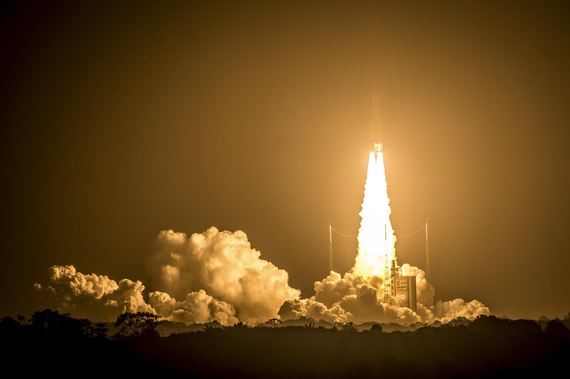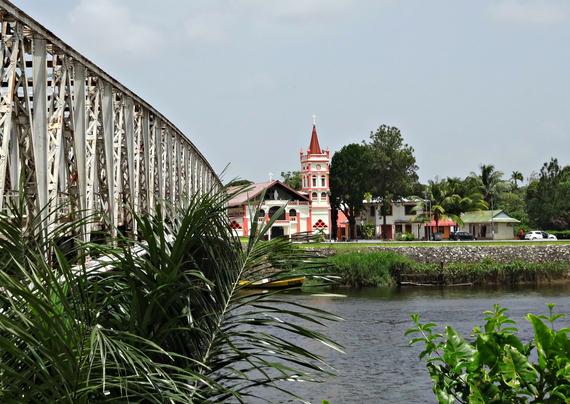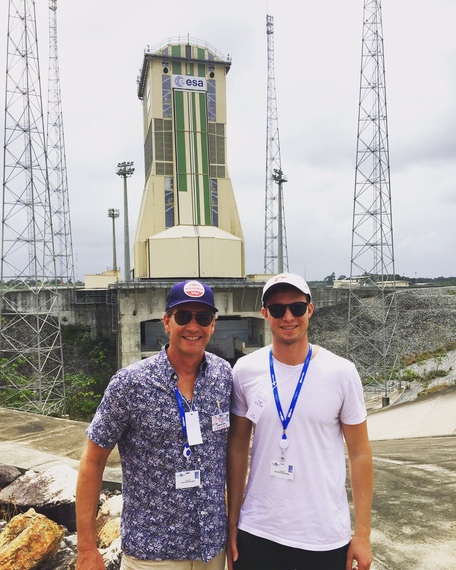Photo by Antoine La Gomme
"Now when I was a little chap I had a passion for maps. I would look for hours at South America, or Africa, or Australia, and lose myself in the glories of exploration. At that time there were many blank spaces on the earth, and when I saw one that looked particularly inviting on a map (but they all look that) I would put my finger on it and say, 'When I grow up I will go there... True, by this time it was not a blank space any more. It had got filled since my boyhood with rivers and lakes and names. It had ceased to be a blank space of delightful mystery--a white patch for a boy to dream gloriously over. It had become a place of darkness."
-- Joseph Conrad, Heart of Darkness
My fascination with the white spaces on maps began before my earliest memories-- on an adventurous family trip to see Apollo 14 launch from the Kennedy Space Center Launch Complex 39A in Merritt Island, Fla., on January 31, 1971--exactly two weeks before my second birthday.
My memories of that trip come from home movies shot at Cape Canaveral by my father, who had procured special tickets for our young family to watch the manned lunar mission escape Earth just a chip shot away from where then-Vice President Spiro Agnew also was observing.
Perched atop my pea-green, short plastic "car seat" on the folded-flat and carpeted tailgate of our 1969 Grand Torino station wagon, I'm sure my father agreed with James T. Kirk's declaration that space was, in fact, the final frontier.
At the time, our family lived in Baltimore where my father was in medical school at Johns Hopkins University. He was a resident and had provided medical services for a secretary who had access to special tickets reserved for military personnel at Cape Canaveral. Despite my mother having just given birth to my sister, Sara, three weeks earlier, we packed up the car with my older brother, Tim (age 3 1/2) and me (almost two). Seeing a launch was that important to my parents.
The idea of driving more than 13 hours with two boys under the age of five and a newborn to watch a lunar mission launch seemed normal when we were growing up, because my parents just did those kinds of things. There was no age-limit to our family (ultimately of six kids) adventures. Whether bareboating in the Out Islands of the Bahamas or visiting dude ranches in Colorado. Toddlers made the same trips as teenagers.
Above is footage of the Apollo 14 launch my father shot with his Super-8 camera in 1971:
Happily, my father's passion for adventure travel became my own and is a rich legacy I've passed on to my own children.
Having taken my first steps on Earth just months after Neil Armstrong took his first steps on the moon in 1969, I harbored fantasies about becoming an astronaut. My older brother and I had NASA jumpsuits, climbed on giant rocket ships at the playground, and drank Tang for breakfast. We rode Space Mountain at Disney World when it first opened (I was five and my mother was six-months-pregnant with my sister, Jane, on my first and her last ride). Later, we explored the future at the Epcot Center and made multiple trips to Florida to witness the first Space Shuttle launches.
In the late 1970s, Star Wars was the only movie that my parents would pay for the whole family to see twice. For Generation X--my generation--space exploration heavily defined who we are and the limits of our imaginations.
Space missions have changed dramatically in my lifetime--the effect they have on our daily lives has become more important even if it feels significantly less romantic to the masses today than in the 1960s and '70s.
The scientific, military, and commercial applications of space exploration help us better understand the world we live in, keep us safer, and make life infinitely more convenient. For example, as I write this, I am flying from Miami to Los Angeles while connected via satellite to the Internet for the entire trip.
As the world becomes more populated and global travel easier and cheaper, open spaces on maps that haven't been filled in completely with names are becoming harder to find. French Guiana is one such space.
The small French overseas department is a unique combination of broad blank spaces for adventure tourists as well as the home of one of the ultimate launching pads to the brightest of the unmarked territories. With its European Spaceport in Kourou, French Guiana offers for space tourism today what Cape Canaveral did in the 1970s.
More than half of the global commercial satellite launches take place at the French Guianan Spaceport each year via Arianespace, the private French space company that was for France what NASA used to be for the United States.
While getting to French Guiana isn't easy and it's hardly a five-star luxury destination for pampered tourists, there are few launch sites on Earth that offer the equivalent of front-row seats like we had at NASA launches in the U.S., during the 1960s and '70s.
When I received the invitation to head to French Guiana with my 21-year-old son, Schuyler, to observe a heavy-lift rocket launch with Arianespace (Schuyler had interned with the company the previous summer), I first needed to spend some time searching the Internet to figure out where I had been invited. Like many American citizens, I had no idea that one of the most active global space centers in the world sits just south of where Dustin Hoffman and Steve McQueen escaped Devil's Island, the former French penal colony, in the 1973 film Papillion.
"Isn't that in Africa?" was a common question I heard from even well-traveled friends. Apparently European space exploration as a notion is as impenetrable to the American imagination as the jungle was to Marlow on his trek to find Kurtz.
Turns out my preconceptions about European space missions were about as naive as my ideas about French Guiana. As is often the way with scientific discovery, going into the jungle--to land that scarcely has been touched by humans--proffers solutions to many of our more complicated modern problems. It's also an enticing destination for Americans (and others) who want to view a space launch and experience pristine empty spaces on maps in one exotic trip.
Civilization is scarce in this corner of the world. French Guiana is similar in geographic size than South Carolina, but has a population that is 20 percent smaller than the city of Greenville. There are so few people and so much foliage in French Guiana's interior that the French Foreign Legion operates its elite jungle warfare school here.
In addition to protecting the Guiana Space Centre, the Legionnaires also are busy defending the border with Brazil against illegal strip miners who are poisoning the environment as they rape the earth to extract gold, like modern day Conquistadors. The borders are loosely mapped and disputed. People pass national boundaries on the frontier without passports and this can cause conflict. Conflict requires defense.
The airport at Cayenne isn't fancy but it's efficient. The total time from exiting the plane until we picked up our bags and got on our bus bound for the space hotels was less than 30 minutes. As Schuyler and I walked outside, the heat, humidity, and rich jungle odors bombarded our senses. This definitely wasn't Orlando, Fla.
Culturally, French Guiana felt like stepping back in time. It's hard to place the era--perhaps somewhere between Harrison Ford's 1980 film Mosquito Coast and a down-market version of Catherine Deneuve's Indochine, (except there is no Hotel Metropole in this Hanoi).
One afternoon we sat along the river in Sinnamary, a place that time and visitors have largely forgotten. Locals seemed friendly enough, but I was scolded for straying from our Arianespace bus and strolling into town on my own. Sinnamary City still retains a WWI monument to fallen French soldiers in the trenches of the Western Front, and many buildings have succumbed to the decay that jungle rain, heat, and humidity invariably bring.
The Sinnamary River is about a couple hundred yards wide, muddy brown and edged with mangroves. Covered riverboats, not unlike Bogey's African Queen, are moored there for fishing as well as taking passengers and supplies farther into the interior.
Lunch that afternoon included options for meat and fish (always order the Acoupa, by the way) as well as an "assortment of game meat fricassee" that delivered on the surprise. When the mixed meat appeared, some of the rich, gamey meat was still in its shell. Armadillo on the half-shell was a culinary first for Schuyler and me.
By and large for most Americans, any romantic fascination with space travel disappeared around the same time as Betamax tapes and Bugle Boy parachute pants did. By the time my sons were growing up, NASA was shutting down. I couldn't take them to watch the launches the way my father had with me. (That it was my son's work with Ariane which garnered me access to both the French Guianan launch and an invitation to meet with Stephan Israel, the CEO of Arianespace, is an irony not lost on me.)
Israel's plans for one of the few profitable space companies that is moving toward more sustainable solutions are impressive, but the question I felt an awkward need to ask was whether Ariane and the European Spaceport were open to more space tourists visiting the center and witnessing a launch?
It wasn't a normal business question. But without hesitation, Israel directly engaged the question and noted a challenge of European space programs is the lack of manned space travel.
"Europe did not have the romanticism of space travel because we did not have manned space flights," Israel said. "It would benefit French Guiana and European space programs to have more public engagement." (Arianespace happily would help arrange visitor access to launches, he added.)
If and when you visit the Guiana Space Centre, part of the adventure is actually standing where launches still happen. We rode on a CSG tour bus through miles of rain forest and savannahs to visit both the smaller Vega (Italian) and Soyuz (Russian) rocket launch facilities. From the Vega launch site, we were able to get within two miles of the Ariane-5 rocket that was being fueled for launch later that evening and had to carry gas masks in the event of a gas leak.
At the space center, there are two main observation areas for the public: Toucan, which is 5 kilometers (roughly three miles) away, an outdoor viewing area--the closest you can get to the launch without needing to be safely inside a blast bunker. Farther out is the Jupiter observation facility, a more refined and VIP indoor viewing experience alongside the senior control room.
Both are interesting places to view a launch, but Schuyler and I opted to view the launch outside-- as close as possible--to feel the vibrations and watch the rocket arc across the night sky with nothing between us but the warm, humid night air.
When we look from space at Earth, the big blue marble, it quickly becomes clear that what we need isn't more boundaries, fences, and borders. Cooperation and partnership are the creative building blocks of a better future. An obvious first step would be to start focusing on how we organize to solve near-term problems with long-term partnerships that bring us closer together and make us more human.
There are few blank places on maps left to explore. Nearly every inch of land and water is named and claimed by nations. Some borders and barriers are in dispute.
The names are what separate us, darkening the white spaces. But space itself remains blank and access to it is what should make nations allies. We ought not create new borders, names, and hearts of darkness when it comes to allowing access to the great blankness of space.
As Schuyler and I stood under a sparsely-clouded night sky, feeling the earth shake and watching the French Ariane-5 successfully lift a US-made Boeing heavy payload communications satellite into geostationary orbit, it reminded me of a memory I only know from the Super-8 film of a tow-headed toddler watching Apollo 14 with his own father 45 years ago.
I wondered where my son's generation will take this planet, and whether our romantic ideas about space and adventure could be glue that holds our Earth together, ultimately making it a better home for all of us.
Photo of the French Ariane-5 launch in French Guiana earlier this year courtesy of Arianespace. Photo of bridge and church in Sinnamary by amanderson2via Creative Commons/Flickr. Photo of David (L) and Schuyler (R) Vanderveen, at the launch site in French Guiana, compliments of the author.


